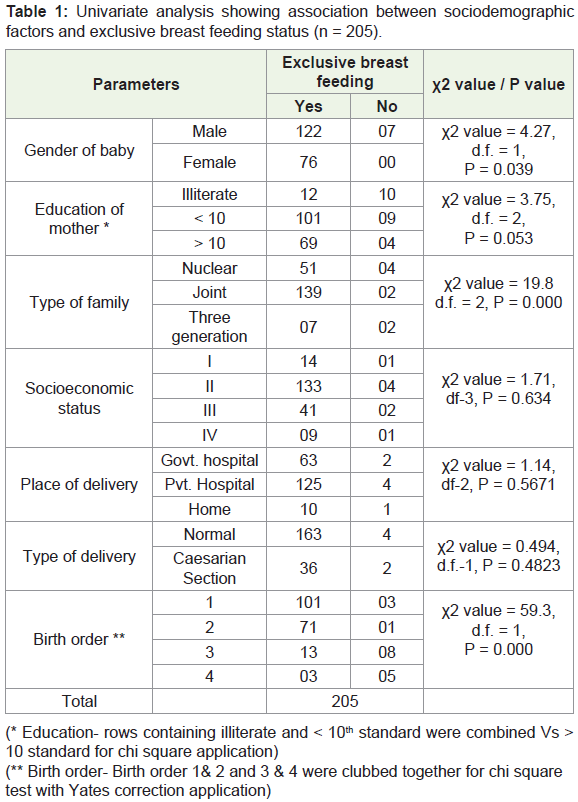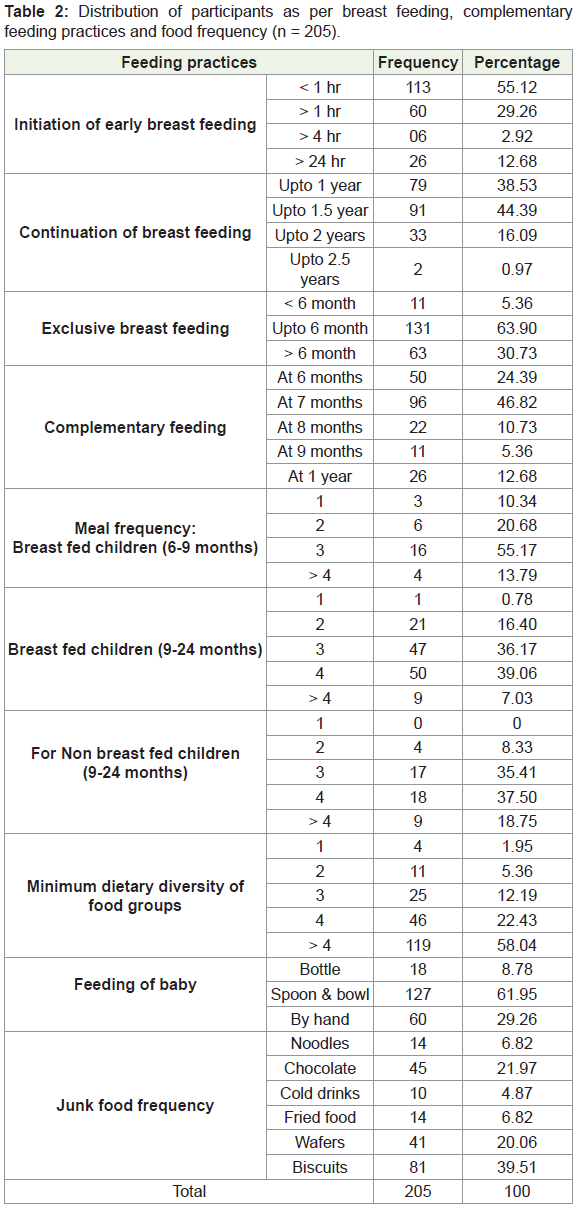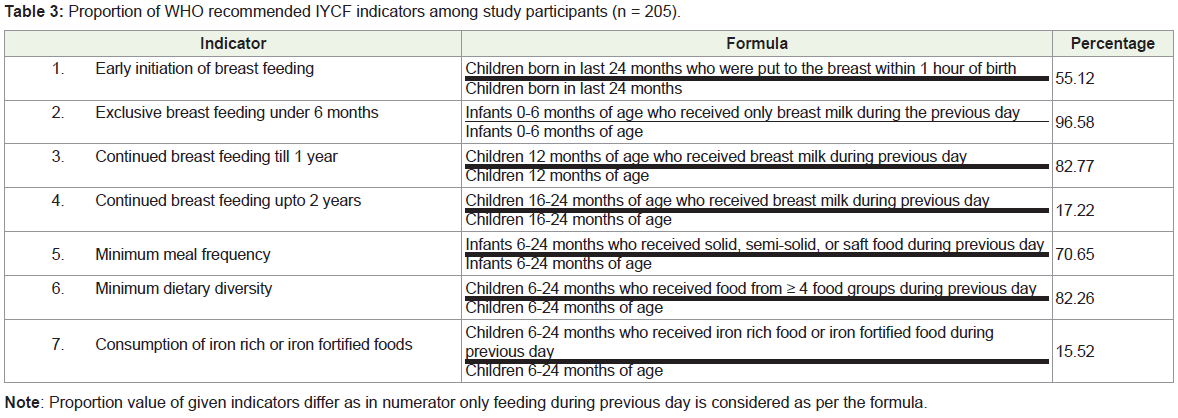Research Article
Study of Infant and Young Child Feeding (IYCF) Practices With Reference to IYCF Indicators among Mothers Attending Immunization Clinic at a Tertiary Care Hospital, Aurangabad (MS)
Nakel MP, Naval SS*, Mahajan SM and Salve SB
Department of Community Medicine, MGM Medical College, India
Corresponding author: Dr. Naval SS, Department of Community Medicine, MGM Medical College, N-6, CIDCO, Aurangabad, Maharashtra, India
Citation: Nakel MP, Naval SS, Mahajan SM, Salve SB. Study of Infant and Young Child Feeding (IYCF) Practices With Reference to IYCF Indicators among Mothers Attending Immunization Clinic at a Tertiary Care Hospital, Aurangabad (MS). Indian J Nutri. 2018;5(2): 188.
Copyright © 2018 Nakel MP, et al. This is an open access article distributed under the Creative Commons Attribution License, which permits unrestricted use, distribution, and reproduction in any medium, provided the original work is properly cited.
Indian Journal of Nutrition | ISSN: 2395-2326 | Volume: 5, Issue: 2
Submission: 15/06/2018; Accepted: 16/07/2018; Published: 19/07/2018
Abstract
Introduction: The optimal infant and young child feeding practices during the first 2 years of life is of paramount importance as this period is the “critical window” for the promotion of health, good growth, behavioral and cognitive development.
Aim: To assess infant and young child feeding practices among mothers.
Objectives: 1. To assess early initiation and exclusive breast feeding practices among mothers.
2. To know complementary feeding practices among the participants.
3. To evaluate diet audit sheet in context to complementary feeding.
Methodology: Study Design- Descriptive Cross-sectional Study Sampling method- Convenient sampling was used. Study Population- Mothers having children of age less than 2 years attending Immunization clinic at MGM hospital, Aurangabad.
Results: It was seen that, educational status of mother and birth order were found to be significantly associated with exclusive breast feeding status. Proportion of breast feeding within 1 hour and > 24 hour was 55.12 and 12.68 respectively. 44.39% of women had continued breast feeding upto the age of 1 and half year. Proportion of exclusive breast feeding upto 6 months was found in 63.90%. 46.82% parents had started complementary feeding at 7 month.
Conclusion: This study revealed reasonably good infant and young child feeding practices, however awareness about few indicators especially proportion of continued breast feeding up to 2 year and consumption of iron rich or iron-fortified foods was strikingly poor.
Keywords:
Breast feeding; Infant and young child feeding practices; Complementary feeding; IYCF Indicators
Introduction
Background
The Infant and Young Child Feeding (IYCF) practices during the first 2 years of life are of utmost importance as this period is called as “critical window” for promotion of physical, behavioral and cognitive development of the growing child. Optimal infant and young child feeding practices include initiation of breast-feeding within 1 hour of birth, exclusive breast-feeding for the first 6 months of life, and continuation of breast-feeding for 2 or more years along with nutritionally adequate, safe, hygienic and age appropriate complementary feeding starting at 6 months of age [1].
It has been well established that because of the best bioavailable iron content in breast milk, early exclusive breast-feeding prevents anemia and diarrheal infections in the child. The need of introducing cereal-based foods in the diet of infant after the age of 6 months can be correlated with the fact that enzyme amylase appears in the seventh month of life in infancy [2]. Exclusive breast-feeding delays next pregnancy, boosts mother’s immunity and reduces the insulin needs of diabetic mothers. Breast-feeding also protects from breast, ovarian cancers and osteoporosis [3].
Mothers Absolute Affection (MAA), a nation-wide intensified programme for promoting breastfeeding has been launched by the Honorable Union Minister of Health and Family Welfare, Government of India on 5th August 2016 in New Delhi for creating an enabling environment to ensure that husbands, families and others should receive adequate information and support for promotion of breastfeeding. The ultimate goal is to strengthen optimal breastfeeding practices, which includes early initiation of breastfeeding within 1 hour of birth, exclusive breastfeeding for first 6 months and continued breastfeeding for at least 2 years along with feeding of safe and wholesome nutritious food on completion of 6 months [4].
Problem statement
Approximately, 1.4 million deaths of children under the age of 5 years worldwide are attributed to suboptimal breast-feeding practices. Almost 6% of under-five mortality can be prevented by the timely introduction of complementary feeding [5]. It was estimated that about one-fifth of overall under-five mortality can be averted if 90% infants are covered with an interventions to promote, protect, and support the optimal Infant Young Child Feeding (IYCF) practices [5]. A large proportion of children become vulnerable to stunting, poor cognitive development and significantly increased risk of diarrhea and acute respiratory infection due to the poor feeding practices [6].
The relationship between poor breast feeding practices and malnutrition is well established. Recent scientific study signifies that malnutrition has been responsible, directly or indirectly for 60% of deaths among five annually. Over 2/3 of these deaths are always associated with inappropriate feeding practices during the first year of life. Only 35% infants worldwide are exclusively breast feed during first 4 months of life and complementary feeding was started either too early or too late with the food that was nutritionally inadequate and unsafe [7].
Study rationale
Poor feeding practices in infancy and early childhood resulting in malnutrition lead to impaired physical, mental and social development in later life. Poor feeding practices are therefore a major threat affecting health of this vulnerable age group. Thus, infant feeding practices that are breast feeding and complementary feeding have major role in determining the nutritional status of the child [7].
Most of the studies conducted in India have focused mainly on breast-feeding aspects and not the dietary diversity and diet frequency aspects, which has immense significance in healthy IYCF practices. With this background and rationale, present study was undertaken to assess the IYCF practices with special emphasis on IYCF indicators.
Aim
To assess infant and young child feeding practices among mothers attending immunization clinic at a tertiary care hospital, Aurangabad, Maharashtra.
Objectives
1. To study early initiation and exclusive breast feeding practices among mothers.
2. To know complementary feeding practices among the participants.
3. To evaluate diet audit sheet in context to complementary feeding.
Methodology
Study design
Descriptive Cross-sectional Study
Research settings
Study was conducted among mothers having child less than 2 years of age, attending immunization clinic at our tertiary care center, Aurangabad.
Study population
Mothers having children of age less than 2 years.
Sample size and sampling technique
With an estimated total proportion (p) of exclusive breast feeding as 56.6 %, with an allowable error (l) of 7%, statistical power of 80% and constant Z=1.96, the required minimum sample size came out to be 205 using the formula, sample size
n = Z2 × p ×q / l 2. (n= Sample size, p= prevalence, q= 1-p).
Total prevalence of exclusive breast feeding i.e. 56.6 % as per National Family Health Survey (NFHS 4) was considered as reference prevalence for calculation of sample size [8].
Sampling technique
Participants were selected by using convenient sampling method to get the desired sample.
Study design
Descriptive Cross-sectional Study
Inclusion and exclusion criteria
Plan of the study
A well structured and self administered pretested questionnaire based on IYCF practices was used for data collection. These questions provide the information needed to calculate the key indicators given by WHO about IYCF outlining exclusive breast feeding and complementary feeding. As per WHO recommendations, information was collected about the child’s diet in the previous 24 hours, which included the type of food items and the number of times they had consumed. Food items were categorized into seven types, that is, cereals, legumes and nuts, dairy products, meat products, egg, vitamin A-rich fruits and vegetables, and other fruits and vegetables. Children less than 24 months were included in the study after obtaining verbal informed consent from the mothers.
Data analysis
Data was entered in MS Excel and the indicators were expressed in frequencies & proportions. Chi square test was used for univariate analysis to find out association between independent and dependent factors. Data was analyzed in SPSS version 20 (trial version).
Results & Observations
Table 1 shows univariate analysis of parameters viz. independent variables like gender of baby, education of mother, type of family, socioeconomic status, place of delivery, type of delivery and birth order with exclusive breast feeding as a dependent variable.
(* Education- rows containing illiterate and < 10th standard were combined Vs > 10 standard for chi square application)
(** Birth order- Birth order 1& 2 and 3 & 4 were clubbed together for chi square test with Yates correction application)
It was seen that, educational status of mother and birth order were found to be significantly associated with exclusive breast feeding status. Educational status of mother was found to be significantly associated with exclusive breast feeding with a p value < 0.0440. Birth order is another important factor that shows statistically significant association with exclusive breast feeding with a p value < 0.0001 calculated by Chi square with Yates correction.
Table 2 shows proportion of breast feeding within 1 hour and > 24 hour was 55.12 and 12.68 respectively. 44.39% of women had continued breast feeding upto the age of 1 and half year. Proportion of exclusive breast feeding upto 6 months was found in 63.90%. 46.82% parents had started complementary feeding at 7 month. 3 times a day meal frequency in breast fed baby (6-9 month age group) was found in 55.17 while 39.06% of babies of age (9-24 months) were fed 4 times a day.
Total of 37.50% non breast fed babies were fed for 4 times a day. Minimum dietary diversity of > 4 food groups was found in 58.04%. Majority of mothers i.e. 61.95% fed their babies by bowl & spoon. Biscuits were the most commonly eaten junk food consumed by 39.51% of babies followed by chocolates (21.97%) and wafers (20.06%).
Table 3 shows highest proportion of exclusive breast feeding i.e. 96.58% considering infants (0-6 months) who received only breast milk during last 24 hour. Proportion of children who were put on breast within 1 hour of birth was 55.12%. While proportion of continued breast feeding upto 2 years and consumption of iron rich food was strikingly low i.e. 17.22% and 15.5% respectively. Total 82.6% of children in 6-24 months age group received ≥ 4 food groups in their diet during the previous day.
Note: Proportion value of given indicators differ as in numerator only feeding during previous day is considered as per the formula.
Discussion
Present study was conducted among mothers having children less than 2 years of age attending immunization clinic at our hospital. As per WHO recommendations, information was collected about the child’s diet in the last 24 hours including the type of food items and the number of times they had consumed. Univariate analysis of parameters viz. independent variables like gender of baby, education of mother, type of family, socioeconomic status, place of delivery, type of delivery and birth order was done with exclusive breast feeding as a dependent variable.
Of the total 205 studied children who were in the age of 0-24 months, 55.12% were put on breast-feeding within 1 hour of birth and 63.90% children were exclusively breast-fed for upto 6 months; as per National Family Health Survey - 4 (NFHS-4) data at the national level showed proportion of exclusively breast-fed for 6 months as 56.60%, which is quite lower than our study [8]. A study from West Bengal had shown it much lower as 13.6% [9]. Breast-feeding was initiated within 1 hour in only 8% cases among Paroja community in Orissa [10].
The present study revealed that initiation of breastfeeding within 1 hour of birth was higher compared to corresponding national (24.5%) figures of the NFHS-3 [11].
The proportion of exclusively breast-fed tribal babies was found to be 67.4% in a study at Thane, Maharashtra which was quite similar to our study [12]. Exclusive breast-feeding up to 6 months was not done in 23.4% children in Jabalpur [13]. All infants older than 6 months were receiving complementary feeds of which 84.6% of infants were introduced before they reached 6 months as studied by P Seonandan [14]. There was early initiation of breast feeding and exclusive breast feeding in 60% of children as studied by Malini Bhattathiry, et al. [15].
Continued breast-feeding at 1 year was being done by 82.77% of children of 12 months of age who received breast feeding on previous day. This was lower as compared with the study in West Bengal, which showed that 91.1% children were continuing breast-feeding [9].
Out of total children belonging to 6-24 months age group, 82.26% were fed with four or more food groups and 70.65% babies were fulfilled with minimum meal frequency. The cut-off of at least 4 of the above 7 food groups above was selected because it is associated with better quality diets for both breastfed and non-breastfed children [16]. Consumption of foods from at least 4 food groups on the previous day would mean that in most populations the child had a high likelihood of consuming at least one animal-source food and at least one fruit or vegetable that day, in addition to a staple food (grain, root or tuber).
Proportion of breast feeding within 1 hour and > 24 hour was 55.12 and 12.68 respectively. 44.39 % of women had continued breast feeding upto the age of 1 and half year. Proportion of exclusive breast feeding upto 6 months was found in 63.90%. 46.82% parents had started complementary feeding at 7 month. 3 times a day meal frequency in breast fed baby (6-9 month age group) was found in 55.17 while 39.06% of babies of age (9-24 months) were fed 4 times a day.
Total of 37.50% non breast fed babies were fed for 4 times a day. Minimum dietary diversity of > 4 food groups was found in 58.04%. Majority of mothers i.e. 61.95% fed their babies by bowl & spoon. Biscuits were the most commonly eaten junk food consumed by 39.51% of babies followed by chocolates (21.97%) and wafer (20.06%) consumption.
Minimum meal frequency: Minimum is defined as, 2 times for breastfed infants 6-8 months, 3 times for breastfed children 9-23 months, 4 times for non-breastfed children 6-23 months. “Meals” include both meals and snacks (other than trivial amounts), and frequency is based on caregiver report.
This indicator is intended as a proxy for energy intake from foods other than breast milk. Feeding frequency for breastfed children includes only non-liquid feeds and reflects the Guiding Principles [17]. Feeding frequency for non-breastfed children includes both milk feeds and solid/semi-solid feeds, and also reflects the Guiding Principles for these children [18].
Conclusions
Acknowledgement
We are thankful to all the study participants without whom it would not have been possible to carry out study. We are wholeheartedly thankful to our Department staff and college officials including Dean MGM Medical College, Aurangabad for giving us the permission & supporting us during the study.
References
- World Health Organization (2009) Infant and Young Child Feeding: Model Chapter for Textbooks for Medical Students and Allied Health Professionals. pp: 99.
- Butte NF, Lopez-Alarcon MG, Garza C (2002) Nutrient adequacy of exclusive breastfeeding for the term infant during the first six months of life. Geneva: World Health Organization, pp: 1-47.
- Jones G, Steketee RW, Black RE, Bhutta ZA, Morris SS (2003) Bellagio Child Survival Study Group. How many child deaths can we prevent this year? Lancet 362: 65-71.
- Key facets of ‘MAA’ - Mothers’ Absolute Affection: A National Breastfeeding Promotion Programme, UNICEF, India.
- Black RE, Morris SS, Bryce J (2003) Where and why are 10 million children dying every year? Lancet 361: 2226-2234.
- WHO (2000) Effect of breastfeeding on infant and child mortality due to infectious diseases in less developed countries: a pooled analysis. WHO Collaborative Study Team on the role of breastfeeding on the prevention of infant mortality. Lancet 355: 451-455.
- (2004) National guidelines on Infant and Young Child Feeding. Ministry of Human Resource Development, Department of Women and Child Development, (Food and Nutrition Board), Government of India pp: 1-26.
- (2017) National family health survey (NFHS-4), 2015-16: India. State fact sheet Maharashtra: International Institute for Population Sciences, Mumbai pp: 3.
- Sinhababu A, Mukhopadhyay DK, Panja TK, Saren AB, Mandal NK, et al. (2010) Infant- and young child-feeding practices in Bankura district, West Bengal, India. J Health Popul Nutr 28: 294-299.
- Patro S, Nanda S, Sahu R (2012) Infant feeding practices of Paroja: a tribal community of Orissa. Stud Home Com Sci 6: 21-25.
- (2007) National family health survey (NFHS-3), 2005-06: India. International Institute for Population Sciences Deonar, Mumbai 1: 540.
- Sudhakar BP, Srivastava SR (2012) Breastfeeding practices and factors associated with it: A cross sectional study among tribal women in khardi primary health centre, Thane, India. Int J Public Health Res 2: 115-121.
- Rao VG, Yadav R, Dolla CK, Kumar S, Bhondeley MK, et al. (2005) Undernutrition & childhood morbidities among tribal preschool children. Indian J Med Res 122: 43-47.
- Seonandan P, McKerrow NH (2016) A review of infant and young child feeding practices in hospital and the home in KwaZulu-Natal Midlands. South Afr J Clin Res 29: 111-115.
- Bhattathiry MM, Kumari S (2016) A study on infant and young child feeding practices among mothers in a selected rural area of Kollam, Kerala. IJHSR 6: 26-30.
- (2007) Working Group on Infant and Young Child Feeding Indicators. Developing and validating simple indicators of dietary quality of infants and young children in developing countries: Additional analysis of 10 data sets. Report submitted to: the Food and Nutrition Technical Assistance (FANTA) Project/Academy for Educational Development (AED).
- WHO/PAHO (2003) Guiding principles for complementary feeding of the breastfed child. Washington, DC, Pan American Health Organization.
- (2005) Guiding principles for feeding non-breastfed children 6-24 months of age. Geneva, World Health Organization, pp: 1-40.



